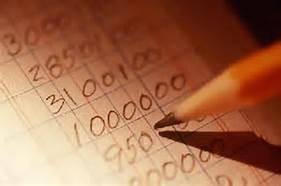Bookkeeping & Accounting
Accounting and Auditing

Accounting is a cycle of work. It involves six steps of the following accounting procedures:
- Journal entries
- Postings
- Trial balance
- Adjustments
- Closing entries
- Financial statements
Below here is how each procedure works. Provided that you do more practices on the procedures, you can handle your company's own accounts.
Journal Entries
The first step in accounting procedures and is also the basis of bookkeeping.
General Journal:
Making of records regarding the customer name, supplier name, transaction date and amount, transaction details etc in the general journal (a format is shown right below).
Document entry:
Journal entries are then made based on double-entry system. Double-entry implies that transactions are always recorded using two sides, debit and credit. A note or receipt is attached for proof and reference.
Below is a list of some ledgers:
| Double entries are made to the following ledgers for each transaction: | ||
Capital Director Deposit Director Withdrawal Current Bank Saving Bank Assets Loans | Purchases Opening Stock Closing Stock Accounts Payable Stock Sales Accounts Receivables Service Income | Expenses
Accrual Prepayment etc. |
| Date: | ||
| Details: | ||
| Amount: | ||
| Debit Entry: | ||
| Credit Entry: | ||
| Journal entries to ledgers for some transactions: | ||
| Transactions | Debit Entry | Credit Entry |
| Director Deposit | Saving Bank | Director's account |
| Director Withdrawal | Director's account | Saving Bank |
| Purchase by cheque | Purchase | Current Bank |
| Purchase by cash | Purchase | Director's account |
| Sale by cheque | Current Bank | Sales |
| Sale by cash | Director's account | Sales |
| Cash deposit in bank | Saving Bank | Director's account |
| Salary paid by cheque | Salaries | Current Bank |
| Rental paid by cheque | Rental | Current Bank |
Sundries paid by cash | Sundries | Director's account |
| Furnitures paid by cheque | Assets | Current Bank |
Postings
Journal entries under the general journal will be posted to repective ledgers. Data on the ledgers is provided for easy reference and preparing the financial statements. Postings are done by transfer of the figures from general journals to the appropriate debit or credit side on the ledgers.
Trial Balance
Trial is a process preparing the trial balance statement for making sure the total amount of debit side is equal to the credit side. If the totals of the trial balance do not agree, the differences may be investigated and resolved before finalizing the financial statements. Trial balance assists in the identification and rectification of errors. On the other hand, all ledger data on trial balance statement helps users to get a general idea on how well the operations done to maintain the business. The trial balance will finally be extracted for the preparation of the financial statements.
An example of the format is shown below:
Tai Man Co Ltd 31/03/2016 Trial Balance Statement | ||
| Ledgers | Debit | Credit |
| Furnitures | 30,000 | |
| Saving Bank | 20,000 | |
| Current Bank | 11,000 | |
| Director's account | 50,000 | |
| Accounts receivable | 50,000 | |
| Accounts Payable | 30,000 | |
| Accrual | 90,000 | |
| Capital | 200,000 | |
| Sales | 470,000 | |
| Purchases | 350,000 | |
| Utility charges | 2,000 | |
| Rental | 150,000 | |
| Wages | 120,000 | |
| Transportation | 5,000 | |
| Stationeries | 2,000 | |
| ____________ | ____________ | |
| Balance Total | 790,000 | 790,000 |
| ========= | ========= | |
Adjustments Account adjustments, also known as adjusting entries, are entries that are made in the ledgers at the end of an accounting period to bring account balances up-to-date. They are made according to the accounting principles where income, expense, asset, and liability accounts are required to reflect their true values when reported in the financial statements. For this reason, adjusting entries are necessary.
There are three main types of adjustments:
1. Accounts Receivable and Payable
- Accounts Receivable: Accounts that have been earned during the period but have not yet been received.
- Accounts payable: Accounts that have been incurred for the period but have not yet been paid.
2. Accrued and Prepaid items
- Accrued items: Cash not paid yet, but the goods or service alreadly obtained
- Prepaid items: Cash paid in advance, but the goods or service obtained after then.
3. Estimated provisions
Two common provisions are as follows:
- Depreciation: the most basic is the straight line method which the depreciable cost of fixed assets is divided equally over the accounting period.
- Bad debts: the operating expenses which the company cannot receive at the end of accounting period.
Closing entries
The amounts under all ledgers in one accounting period should be closed or brought to zero so that they won't be mixed with those of the next period. Closing entries are based on the account balances in an adjusted trial balance. Closing entries for temporary accounts consist of all revenuse and expenses should be done and made to zero. However, for permanent accounts involving assets, liabilities and interests of the shareholders, balance is never closed. Instead, the balance will be accumulated.
Financial Statements
(1) Profit and Loss Statement
Profit and Loss Statement is one of the financial statements that provides information on the business status of a company. It also involves a profit and loss appropriation account for partnership companies. Profit and loss appropriation account shows how the company profits distribute among the partners.
The principle of drafting a profit and loss statement is based on the receivable and payable concept. Figures of all revenues and expenditures from trial balance statement will be placed on profit and loss statement. A simpler approach is adopted like profit or loss is determined by subtracting the total expenditures from the total revenues.
In sales and purchases business, the net profit is determined by a complicated approach where operating costs is deducted from gross profit. A sample of the statement is shown in the following diagram:
Tai Man Co Ltd Profit and Loss Account 01/04/2015-31/03/2016 | ||
| Ledgers | $ | $ |
| Sales income | 1,000,000 | |
| Less: Cost of Sales | ||
| Opening stock | 50,000 | |
| Add: Purchases | 550,000 | |
| | -------------- | |
| 600,000 | ||
| Less: Closing stock | (100,000) | |
| (500,000) | ||
| -------------- | -------------- | |
| Gross Profit | 500,000 | |
Less: Operating expenses | ||
| Salaries | 150,000 | |
| Management fee | 8,000 | |
| Rental | 90,000 | |
| Rates | 4,000 | |
| Delivery charges | 1,500 | |
| Repairs | 1,200 | |
| Softwares | 200 | |
| Water | 100 | |
| Electricity | 5,000 | |
| Stamp charges | 200 | |
| Stationeries | 150 | |
| Depreciation | 10,000 | |
| Bad debts | 7,000 | |
| (277,350) | ||
| -------------- | -------------- | |
| Net Profit | 222,650 | |
| ======= | ||
(2) Balance Sheet
Balance Sheet mainly presents the financial position based on the assets, liabilities and shareholders' interests. The principle of the equation, assets equal to liabilites and shareholders' interests, is applied on balance sheet. The business status is exactly the last day of the accounting cycle. With the completion of all previous accounting procedures, balance sheet can be finalized at the end. Balance sheet can tell the investors how much assets a company owns, how much it owes to other parties and how wealthy the shareholders are. All accumulated accounts from trial balance statement are classified under the following categories:
- Assets
Sorted by the level of liquidity (the time required for an asset to become cash)
- Liabilities
Sorted by from the sooner date of full repayment
- Shareholders' Interests
Shares Capital classifiedRetained earnings accumulated all years
Tai Man Co Ltd Balance Sheet 31/03/2016 | ||
| $ | $ | |
| Fixed Assets | ||
| Vehicles | 250,000 | |
| Less: Accumulated Depreciation | (7,500) | 242,500 |
| -------------- | ||
| Furnitures | 100,000 | |
| Less: Accumulated Depreciation | (30,000) | 70,000 |
| -------------- | ||
| Current Assets | ||
| Stock | 55,000 | |
| Bank | 280,000 | |
| Cash | 80,000 | 415,000 |
| -------------- | -------------- | |
| 727,500 | ||
| ======= | ||
| Capital | 300,000 | |
| Short term liabilities | ||
| Accounts payable | 100,500 | |
| Interest payable | 27,000 | 127,500 |
| -------------- | ||
| Long term liabilities | ||
| Mortgaged loan | 300,000 | |
| -------------- | ||
| 727,500 | ||
| ======= | ||


